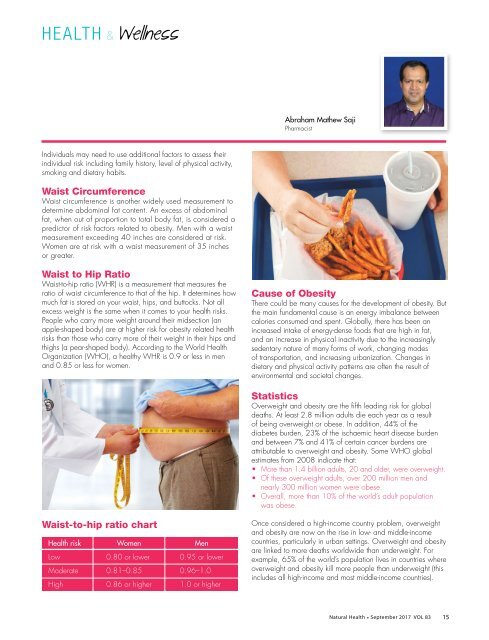Natural Health September 2017
Create successful ePaper yourself
Turn your PDF publications into a flip-book with our unique Google optimized e-Paper software.
HEALTH & Wellness<br />
Abraham Mathew Saji<br />
Pharmacist<br />
Individuals may need to use additional factors to assess their<br />
individual risk including family history, level of physical activity,<br />
smoking and dietary habits.<br />
Waist Circumference<br />
Waist circumference is another widely used measurement to<br />
determine abdominal fat content. An excess of abdominal<br />
fat, when out of proportion to total body fat, is considered a<br />
predictor of risk factors related to obesity. Men with a waist<br />
measurement exceeding 40 inches are considered at risk.<br />
Women are at risk with a waist measurement of 35 inches<br />
or greater.<br />
Waist to Hip Ratio<br />
Waist-to-hip ratio (WHR) is a measurement that measures the<br />
ratio of waist circumference to that of the hip. It determines how<br />
much fat is stored on your waist, hips, and buttocks. Not all<br />
excess weight is the same when it comes to your health risks.<br />
People who carry more weight around their midsection (an<br />
apple-shaped body) are at higher risk for obesity related health<br />
risks than those who carry more of their weight in their hips and<br />
thighs (a pear-shaped body). According to the World <strong>Health</strong><br />
Organization (WHO), a healthy WHR is 0.9 or less in men<br />
and 0.85 or less for women.<br />
Cause of Obesity<br />
There could be many causes for the development of obesity. But<br />
the main fundamental cause is an energy imbalance between<br />
calories consumed and spent. Globally, there has been an<br />
increased intake of energy-dense foods that are high in fat,<br />
and an increase in physical inactivity due to the increasingly<br />
sedentary nature of many forms of work, changing modes<br />
of transportation, and increasing urbanization. Changes in<br />
dietary and physical activity patterns are often the result of<br />
environmental and societal changes.<br />
Waist-to-hip ratio chart<br />
<strong>Health</strong> risk Women<br />
Low<br />
0.80 or lower<br />
Moderate 0.81–0.85<br />
High<br />
0.86 or higher<br />
Men<br />
0.95 or lower<br />
0.96–1.0<br />
1.0 or higher<br />
Statistics<br />
Overweight and obesity are the fifth leading risk for global<br />
deaths. At least 2.8 million adults die each year as a result<br />
of being overweight or obese. In addition, 44% of the<br />
diabetes burden, 23% of the ischaemic heart disease burden<br />
and between 7% and 41% of certain cancer burdens are<br />
attributable to overweight and obesity. Some WHO global<br />
estimates from 2008 indicate that:<br />
• More than 1.4 billion adults, 20 and older, were overweight.<br />
• Of these overweight adults, over 200 million men and<br />
nearly 300 million women were obese.<br />
• Overall, more than 10% of the world’s adult population<br />
was obese.<br />
Once considered a high-income country problem, overweight<br />
and obesity are now on the rise in low- and middle-income<br />
countries, particularly in urban settings. Overweight and obesity<br />
are linked to more deaths worldwide than underweight. For<br />
example, 65% of the world’s population lives in countries where<br />
overweight and obesity kill more people than underweight (this<br />
includes all high-income and most middle-income countries).<br />
<strong>Natural</strong> <strong>Health</strong> * <strong>September</strong> <strong>2017</strong> VOL 83<br />
15

















